Rogue Basin
WaterWatch of Oregon continues to be a leader in the Rogue Basin in one of the nation’s most substantial dam removal and river restoration efforts, but more work is needed to protect and restore this incredible natural resource.
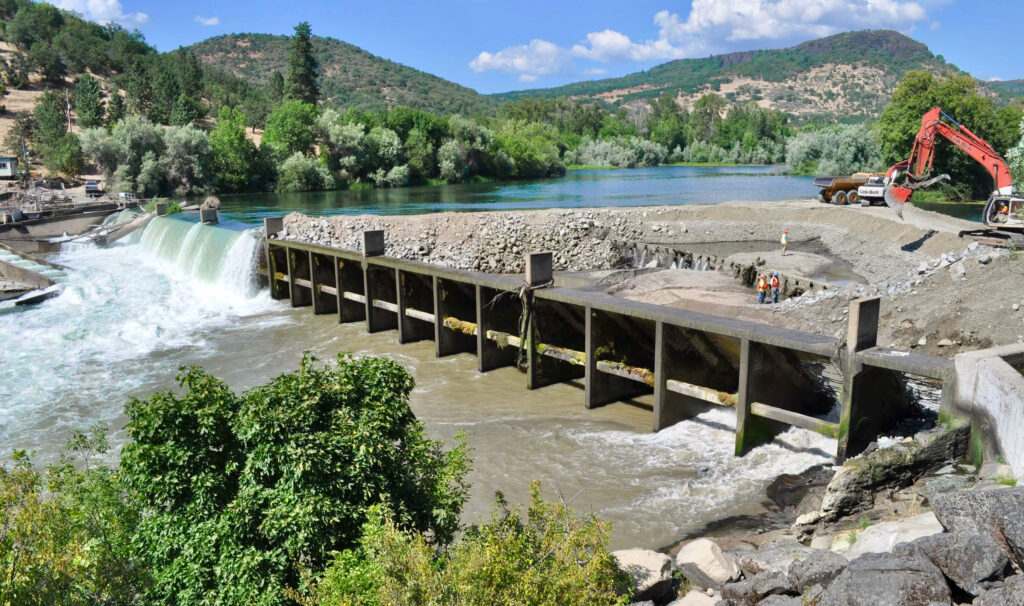
Free the Rogue!
One of the nation’s most beloved waterways, the Rogue River is one of the 12 original Wild and Scenic Rivers recognized by Congress in 1968 as part of the National Wild and Scenic Rivers Act, and visitors travel from around the world to experience this extraordinary river and watershed.
Historically, the Rogue River produced the greatest volume of wild salmon and steelhead in Oregon outside the Columbia Basin. However, coho salmon are now listed as threatened under the Endangered Species Act, and spring chinook and steelhead are declining.
To reverse this trend, WaterWatch has worked for decades to remove significant fish barriers and improve flows to benefit the Rogue’s fish populations, while enhancing fishing and recreational opportunities. Our staff have played an instrumental role in agreements behind the removal of seven Rogue Basin dams and the largest instream water transfer in the Rogue’s history.
Combined, these achievements represent one of the most substantial dam removal and river restoration efforts undertaken in the United States. Even so, much work remains to protect this incredible resource — and WaterWatch remains a leader in continuing Rogue River restoration efforts.

In the Rogue Basin, we’ve worked to remove barriers on the mainstream Rogue River and key spawning tributaries, and converted a 517 million-gallon-per-day water right to an instream water right to protect mainstem river flows forever. Together, we’ve reestablished one of the longest reaches of free-flowing river in the West — now at 157 miles — and protected the water necessary to ensure the river’s health for future generations.
Ongoing Work
Pomeroy Dam Removal
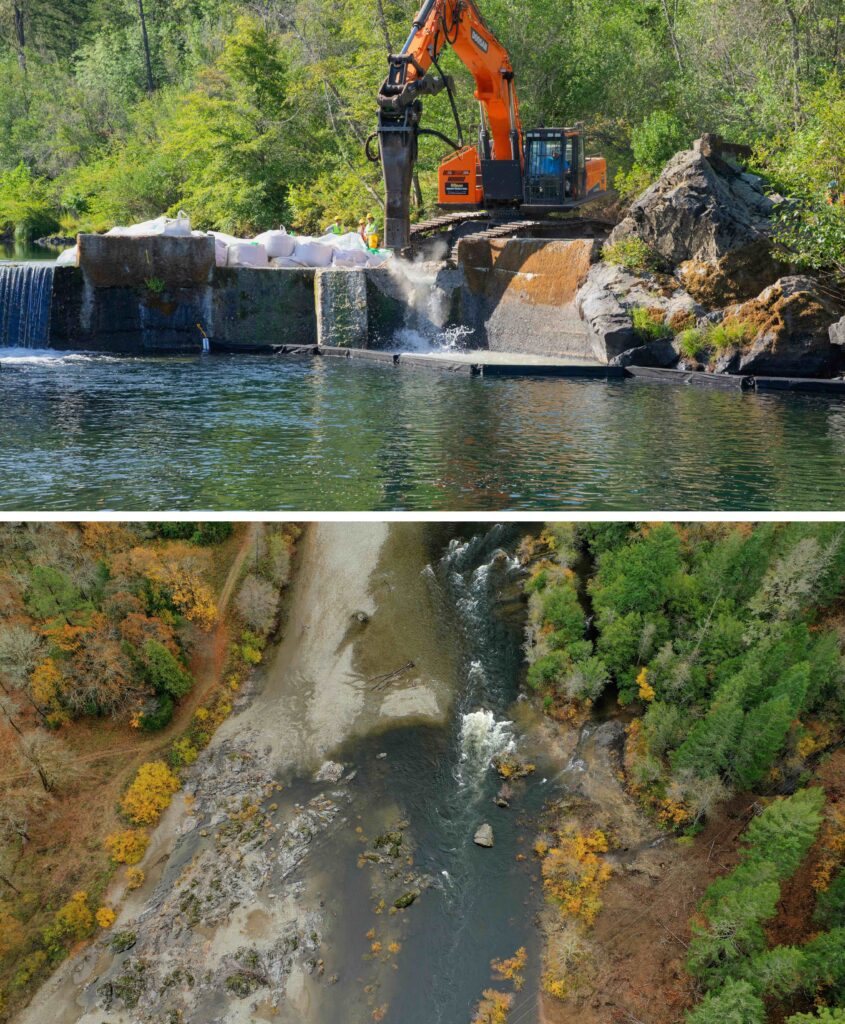
Photos courtesy of Crystal Nichols (top) and Dustin Saigo (bottom).
With the demolition and removal of Pomeroy Dam, the 56 miles of the mainstem Illinois River are now entirely free-flowing for the first time in 126 years, from the river’s beginnings within Illinois River Forks State Park near Cave Junction in Josephine County, to its confluence with the Rogue River near Agness in Curry County.
Listed among the state’s highest-priority fish passage barriers for years, demolition of the 10-foot high, 270-foot wide dam restored access to over 100 miles of salmon and steelhead habitat, and marks the second fish-impeding dam (after Takelma Creek) WaterWatch has removed from the Illinois basin in two years.
The multi-faceted first phase of the Pomeroy Dam removal project also replaced the dam’s water diversion function with two fish-friendly, screened, and metered pump diversions constructed approximately two miles downstream from the former dam site, replaced two fish-blocking Josephine County culverts on West Side Road with safer, fish-friendly culverts, and began decommissioning two miles of leaky earthen water delivery canal between the former dam and new diversion pump sites.
Project construction will continue into 2025 and will primarily include improvements to private on-ranch irrigation and road infrastructure that also correct barriers to native migratory fish. There’s more at our WaterWatch press release announcing the dam’s removal, and press coverage at our media and press page.
Williams-Whalen Dam Removal

Before and after photos courtesy of Crystal Nichols.
Williams-Whalen Dam was one of several dams earmarked for removal as part of the Oregon Department of Fish and Wildlife 2019 Statewide Fish Passage Barrier Priority List, and in June 2024 became the third fish-impeding dam to be removed from Evans Creek since 2015, improving access to some 37 miles of spawning and rearing habitat for salmon and steelhead, with the creek now entirely free-flowing at the former dam site for the first time in 128 years.
State and federal agencies have long identified Evans Creek as a critical waterway for improving access to quality fish habitat in its upper reaches, and an important component in the recovery of Southern Oregon / Northern California Coast Coho salmon, listed as threatened under the federal Endangered Species Act. In addition to Coho salmon, Evans Creek provides spawning and rearing habitat for fall Chinook salmon, summer and winter steelhead, cutthroat trout, Klamath smallscale suckers, and Pacific lamprey.
Click here for more about the removal of Williams-Whelan Dam, with additional photos and video by Crystal Nichols and SeaRun Media. Find a clip by Crystal Nichols on the dam’s removal at our WaterWatch YouTube page as well.
Takelma Creek Dam Removal
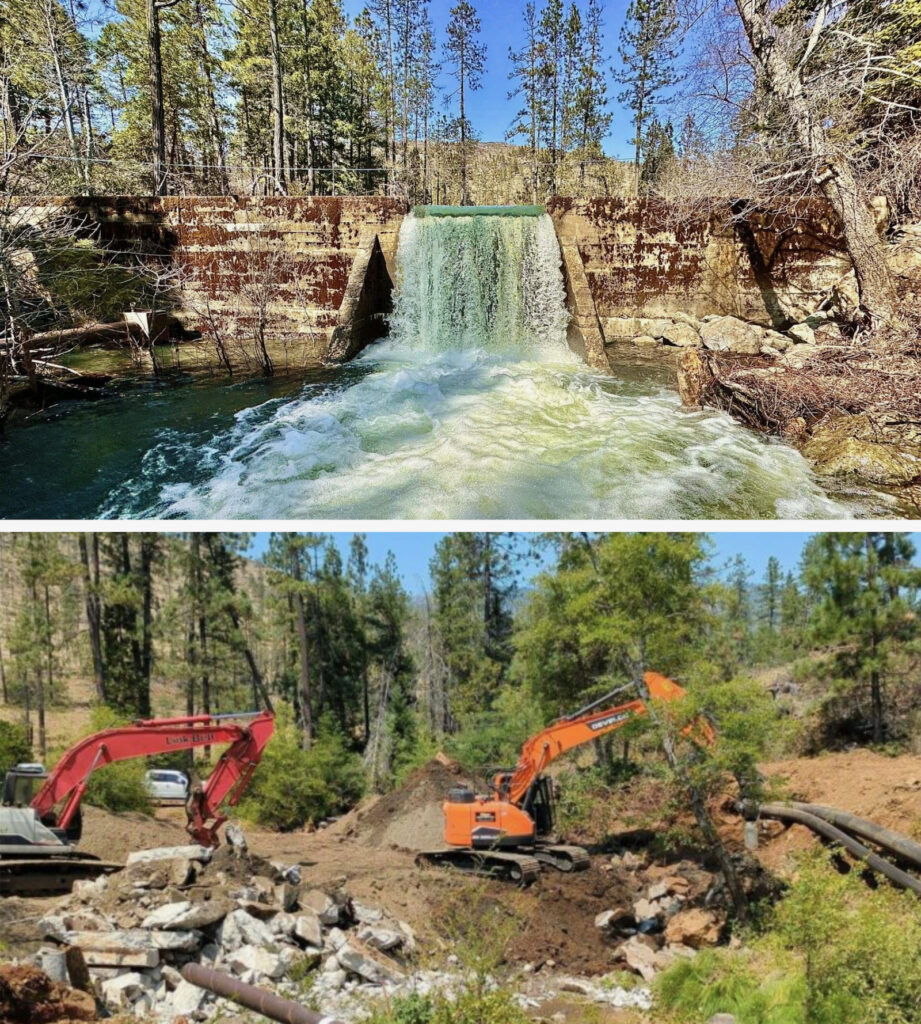
Takelma Creek Dam photos courtesy of River Design Group.
September 2023 saw crews complete demolition of the 13-foot high, 70-foot wide concrete diversion dam on Takelma Creek, part of a larger collaborative effort to restore access to habitat for native salmon and steelhead on this key spawning subbasin of Deer Creek, itself part of the Illinois River subbasin of the Rogue River.
Listed under its former name of Squaw Creek Dam on the 2019 Statewide Fish Passage Barrier Priority List by the Oregon Department of Fish and Wildlife (ODFW), the Takelma dam became the second priority fish-impeding dam to be removed from the Rogue Basin in 2023, opening access to approximately 3.5 miles of formerly blocked spawning and rearing habitat for salmon and steelhead.
And in the wake of this summer’s discovery by U.S. Forest Service personnel that Coho salmon and steelhead are now upstream of the former dam site, we’ve also learned the Bureau of Land Management’s Grants Pass Field Office received the 2024 Western District American Fisheries Society Award of Excellence in Riparian Management for their role in implementing the project. Congratulations to our project partners with the BLM!
Click here for more on the Takelma Creek Dam removal project and demolition, along with this Rogue Valley Times story about the dam’s removal with quotes from WaterWatch’s Jim McCarthy.
Lovelace Dam Removal

Before and after photos of Lovelace Dam along Slate Creek.
An abandoned concrete mill dam, crews finished demolition of the Lovelace Dam structure in July 2023 as part of a larger collaborative effort to restore access to habitat for native salmon and steelhead in Slate Creek, a key spawning tributary of the Rogue Basin’s Applegate River. Lovelace Dam became the fourth fish-impeding dam to be removed from Slate Creek since 2020, and the fifth dam removed overall in the wider Applegate subbasin during the same time period.
Lovelace Dam was also the first dam removal in the nation across the finish line among restoration projects receiving funding from NOAA Fisheries under the federal Bipartisan Infrastructure Law. The project also represented one of the many restoration projects in Oregon accelerated thanks to an ODFW grant awarded out of $8 million in drought funds appropriated to fish passage improvement projects during the 2022 legislative session. With the removal of Lovelace Dam, Slate Creek is now entirely free-flowing at the former dam site for the first time in at least a century.
Click here for more about the removal of Lovelace Dam and more photos from the Rogue River Watershed Council.
Slate and Welter Dam Removals
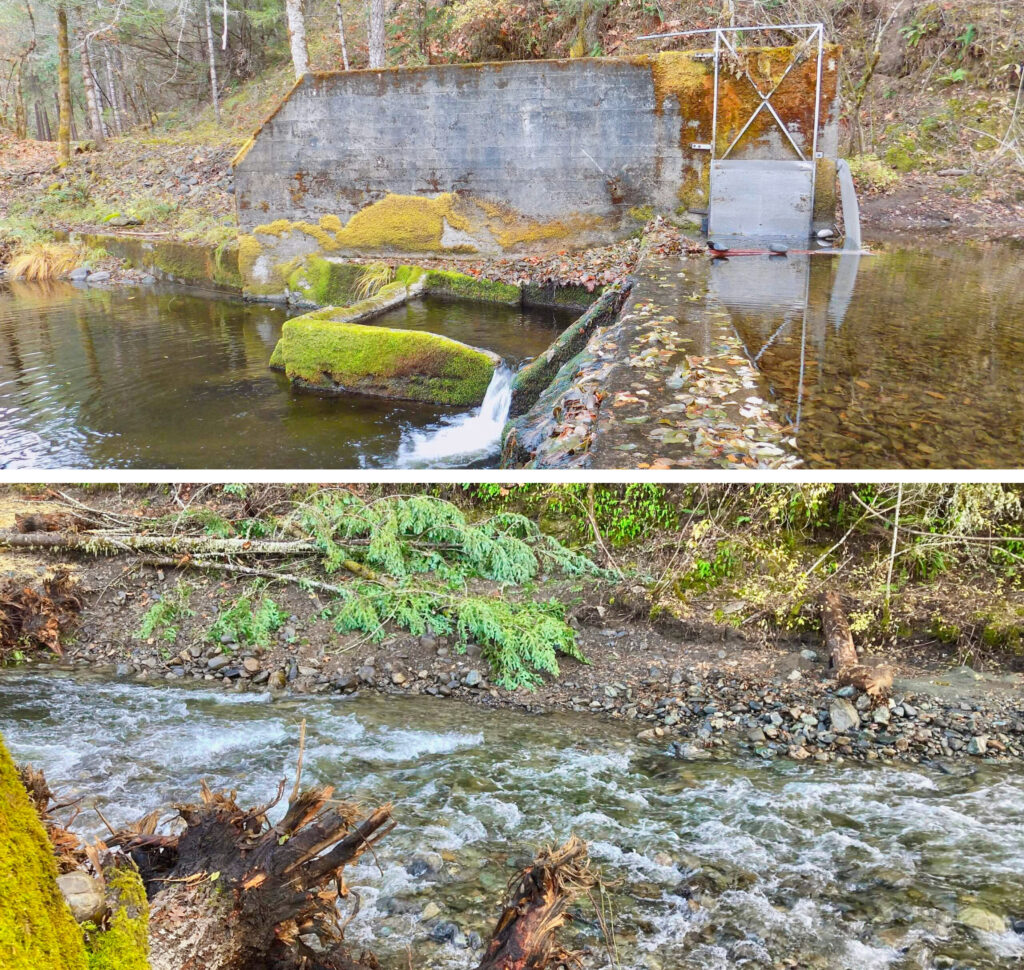
Before and after photos of the Slate Creek Dam
Crews wrapped up demolition on three obsolete concrete dams in the fall of 2021 as part of a WaterWatch-led collaborative project to restore access to habitat for native salmon and steelhead in Slate Creek, a key spawning tributary of the Rogue Basin’s Applegate River.
Santilla Dam, listed on the 2019 Statewide Fish Passage Barrier Priority List by the Oregon Department of Fish and Wildlife, came out along with two other fish-blocking dams on Slate tributary Welter Creek.
This multi-faceted project significantly improved access to approximately 15 miles of spawning and rearing habitat, replaced the dams’ water diversion function with a fish-friendly, solar powered, screened, and metered pump, replaced 1,000 feet of leaky concrete canal with new pipe, removed a relic road abutment from Slate Creek, and decommissioned a section of logging road along Welter Creek.
Fielder and Wimer Dam Removals
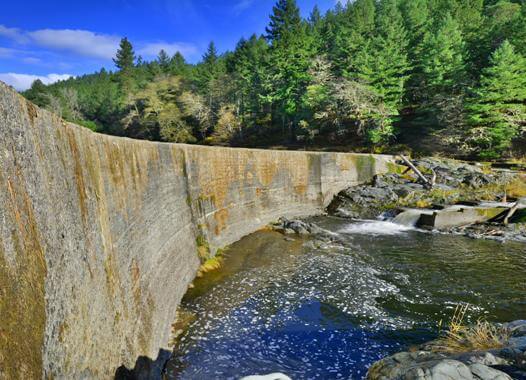
The former Fielder Dam on Evans Creek
In a major development for the Rogue Basin’s prized salmon and steelhead runs, WaterWatch secured removal agreements for Fielder and Wimer dams on Evans Creek, then worked with partners to raise the significant funds necessary to remove these dams during the summer of 2015.
An important spawning tributary of the Rogue River, Evans Creek supports fall chinook salmon, coho salmon, summer and winter steelhead, cutthroat trout, suckers, and lamprey. Removal of the dams improved access upstream to approximately 19 miles of habitat for fall chinook production, 60 miles for coho salmon production, and 70 miles for steelhead production.
Gold Hill Irrigation District Fish Passage Improvement Project
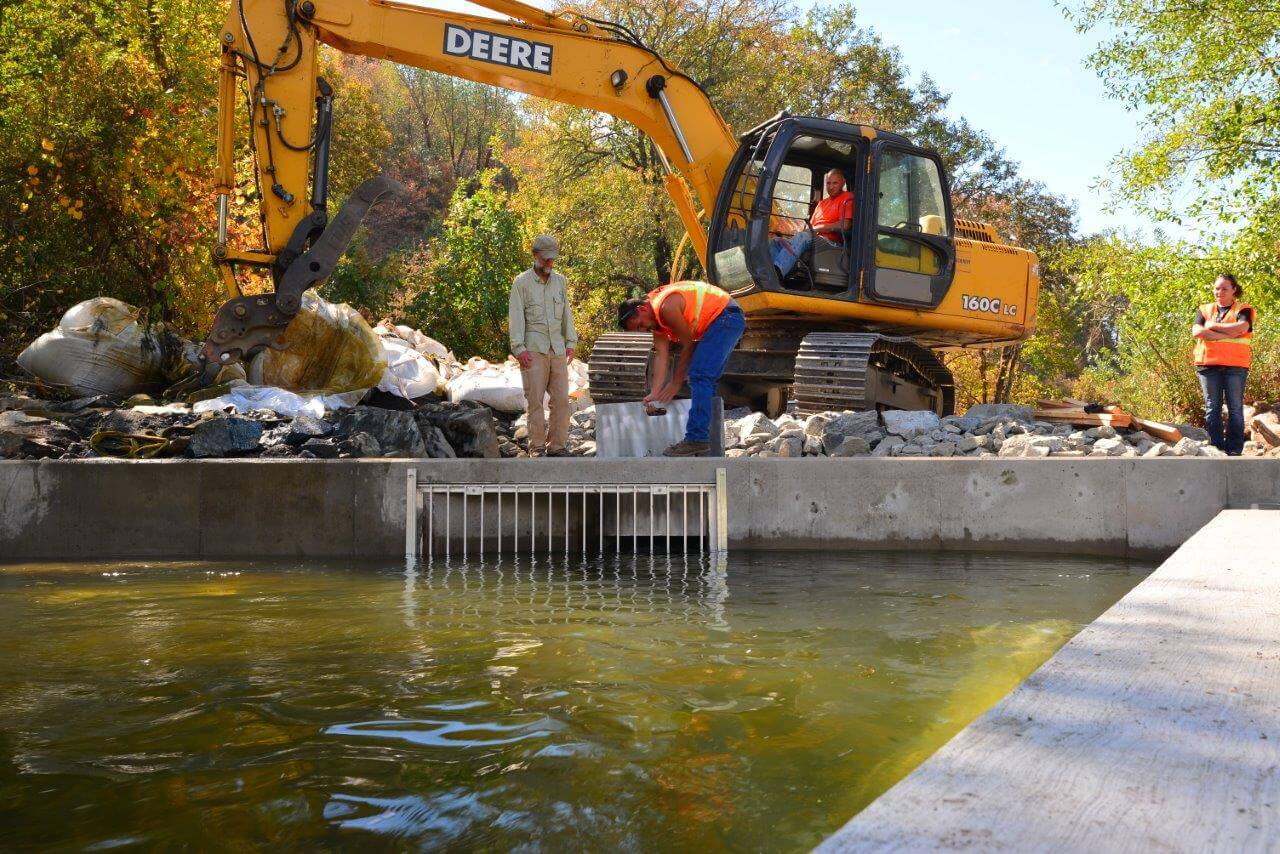
Improvement of GHID’s diversion on the Rogue River underway
WaterWatch and others worked with the Gold Hill Irrigation District (GHID) to improve fish passage at its irrigation diversion system on the mainstem of the Rogue River.
Following the removal of Savage Rapids Dam, City of Gold Hill Dam, and Gold Ray Dam, as well as the notching of Elk Creek Dam, GHID’s diversion dam was the highest-ranking fish passage priority on the Rogue Basin Fish Access Technical Team’s priority list on the mainstem of the Rogue River.
This project benefits spring and fall chinook salmon, summer and winter steelhead, coho salmon, cutthroat trout, and lamprey. Completed in the fall of 2016, the changes in the diversion system also increased flows in a quarter-mile stretch of the Rogue River, improved navigation through Nugget Falls, and allowed for safer public access to the river.
Learn More
For more about how WaterWatch of Oregon achieved its goal of freeing the lower 157 miles of the Rogue River and restoring streamflows, check out our Free the Rogue campaign video.
Rogue River dam removals are expected to provide a boost to the river’s coho salmon, and augment runs of spring and fall chinook salmon, summer and winter steelhead, resident cutthroat trout, and Pacific lamprey. For more on how these dams have been removed, and the benefits to the basin and the region, check out our pages on:
